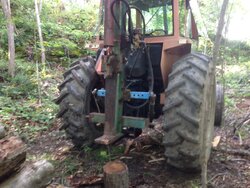So I've wondered about electric splitters before, and after a lot of conversation on this board and thinking about it more and more, I've decided it's not worth it.
My wife and I are looking at getting a homesteam/small farm, and will be growing our own food, and maybe some more, in at least 1 acre of fields. That means a tractor will be available, and not some lawn tractor. Being on a budget, I'm thinking something along the very vague lines of an older Ford 3000 (or something equivalent).
Now, this tractor will have between 35 and 40 HP at the PTO. I'm looking at all the available things which it's going to be used for. Bushhog and finishing mowers, of course. Pulling a plow/disk/rototiller, obviously. But also to serve as a generator, and as a log splitter.
A splitter with a pump such as this - http://www.surpluscenter.com/Brands...RINCE-HC-PTO-1A-PTO-PUMP-540-RPM-9-1047-1.axd - 21gpm @ 2000 PSI (32hp to make that happen!)
That means a 6" diameter, 24" long piston with a capacity of 2.94 gallons would be fully extended in 8.4s with the force of 28 tons. If I can find a pump with a higher pressure that would be even better.
That's impressive enough, yes? Something like that would be able to handle a 6 way wedge don't you think? This, for now, is all a thought experiment.
My wife and I are looking at getting a homesteam/small farm, and will be growing our own food, and maybe some more, in at least 1 acre of fields. That means a tractor will be available, and not some lawn tractor. Being on a budget, I'm thinking something along the very vague lines of an older Ford 3000 (or something equivalent).
Now, this tractor will have between 35 and 40 HP at the PTO. I'm looking at all the available things which it's going to be used for. Bushhog and finishing mowers, of course. Pulling a plow/disk/rototiller, obviously. But also to serve as a generator, and as a log splitter.
A splitter with a pump such as this - http://www.surpluscenter.com/Brands...RINCE-HC-PTO-1A-PTO-PUMP-540-RPM-9-1047-1.axd - 21gpm @ 2000 PSI (32hp to make that happen!)
That means a 6" diameter, 24" long piston with a capacity of 2.94 gallons would be fully extended in 8.4s with the force of 28 tons. If I can find a pump with a higher pressure that would be even better.
That's impressive enough, yes? Something like that would be able to handle a 6 way wedge don't you think? This, for now, is all a thought experiment.


 )
)